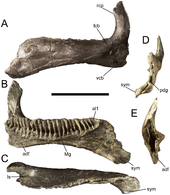Eolambia
| Eolambia Temporal range: Late Cretaceous, 98.5 Ma | |
|---|---|
 | |
| A: Skull reconstruction. B: Life restoration. | |
| Scientific classification | |
| Kingdom: | Animalia |
| Phylum: | Chordata |
| Class: | Reptilia |
| Clade: | Dinosauria |
| Order: | †Ornithischia |
| Suborder: | †Ornithopoda |
| Clade: | †Hadrosauriformes |
| Superfamily: | †Hadrosauroidea |
| Genus: | †Eolambia |
| Type species | |
| †Eolambia caroljonesa Kirkland, 1998 | |
Eolambia is a genus of herbivorous iguanodontian dinosaur from the early Late Cretaceous Epoch of the USA.
Discovery

In 1992 Carole Jones and her husband Ramal Jones near Castle Dale in Emery County, Utah, on the San Rafael Swell Anticline discovered a fossil site which would be named the Carol Quarry (sic) in her honour. Among the fossils were the remains of a euornithopod reported upon by James Ian Kirkland in 1994.[1] Based on these fossils the type species Eolambia caroljonesa was named by Kirkland in 1998. The generic name comes from the Greek eos/ἠώς meaning 'dawn' or 'morning', implying 'early'. The Lambia suffix is after Lawrence Lambe, Canadian palaeontologist, whose name was given to Lambeosaurus. In all, the genus name means "dawn (or early) lambeosaurine". The specific name honours Carole Jones.[2] The genus and species were also known informally before publication as "Eohadrosaurus caroljonesi"; the final name was suggested by Michael Skrepnick.
The holotype specimen, CEUM 9758, was found in the Mussentuchit Member of the Cedar Mountain Formation, probably dating to the Cenomanian, about 98.5 million year ago, though earlier estimates gave the age as the late Albian. It consists of a partial skull. Partial skeletons of adult and juvenile exemplars have been recovered together with eggs and embryos. The paratypes are CEUM 5212, CEUM 27749 and CEUM 24389. Referred specimens include OMNH 28919, OMNH 28511, OMNH 27749 and OMNH 04202. The finds represent at least eleven individuals and most elements of the skeleton.
The holotype skull has a length of about a metre and Kirkland from this inferred a body length of nine metres. The skull is relatively flat and elongated. Gregory S. Paul estimated a body length of six metres and a weight of one tonne in 2010.[3]
Kirkland originally assigned Eolambia to the Hadrosauridae, considering it the basal-most member of the Lambeosaurinae. Later analyses showed that Eolambia was a basal member of the Hadrosauroidea, outside of the Hadrosauridae.[4] It was closely related to Probactrosaurus.[5]
Notes
- ↑ J.I. Kirkland and D. Burge, 1994, "A large primitive hadrosaur from the Lower Cretaceous of Utah", Journal of Vertebrate Paleontology 14(3, suppl.):32A
- ↑ J.I. Kirkland, 1998, "A new hadrosaurid from the upper Cedar Mountain Formation (Albian-Cenomanian: Cretaceous) of eastern Utah - the oldest known hadrosaurid (lambeosaurine?)", In: Lower and Middle Cretaceous Terrestrial Ecosystems, S. G. Lucas, J. I. Kirkland & J. W. Estep (eds.). New Mexico Museum of Natural History and Science Bulletin 14: 283-295
- ↑ Paul, G.S., 2010, The Princeton Field Guide to Dinosaurs, Princeton University Press p. 294
- ↑ Head, J.J., 1999, "A reassessment of the phylogenetic status of Eolambia caroljonesa (Ornithischia: Iguanodontia), with comments on the North American iguanodontian record", Journal of Vertebrate Paleontology 19 (supplement to 3):50A
- ↑ McDonald, A. T.; Bird, J.; Kirkland, J. I.; Dodson, P. (2012). Evans, David C, ed. "Osteology of the Basal Hadrosauroid Eolambia caroljonesa (Dinosauria: Ornithopoda) from the Cedar Mountain Formation of Utah". PLoS ONE. 7 (10): e45712. doi:10.1371/journal.pone.0045712. PMC 3471925
 . PMID 23077495.
. PMID 23077495.